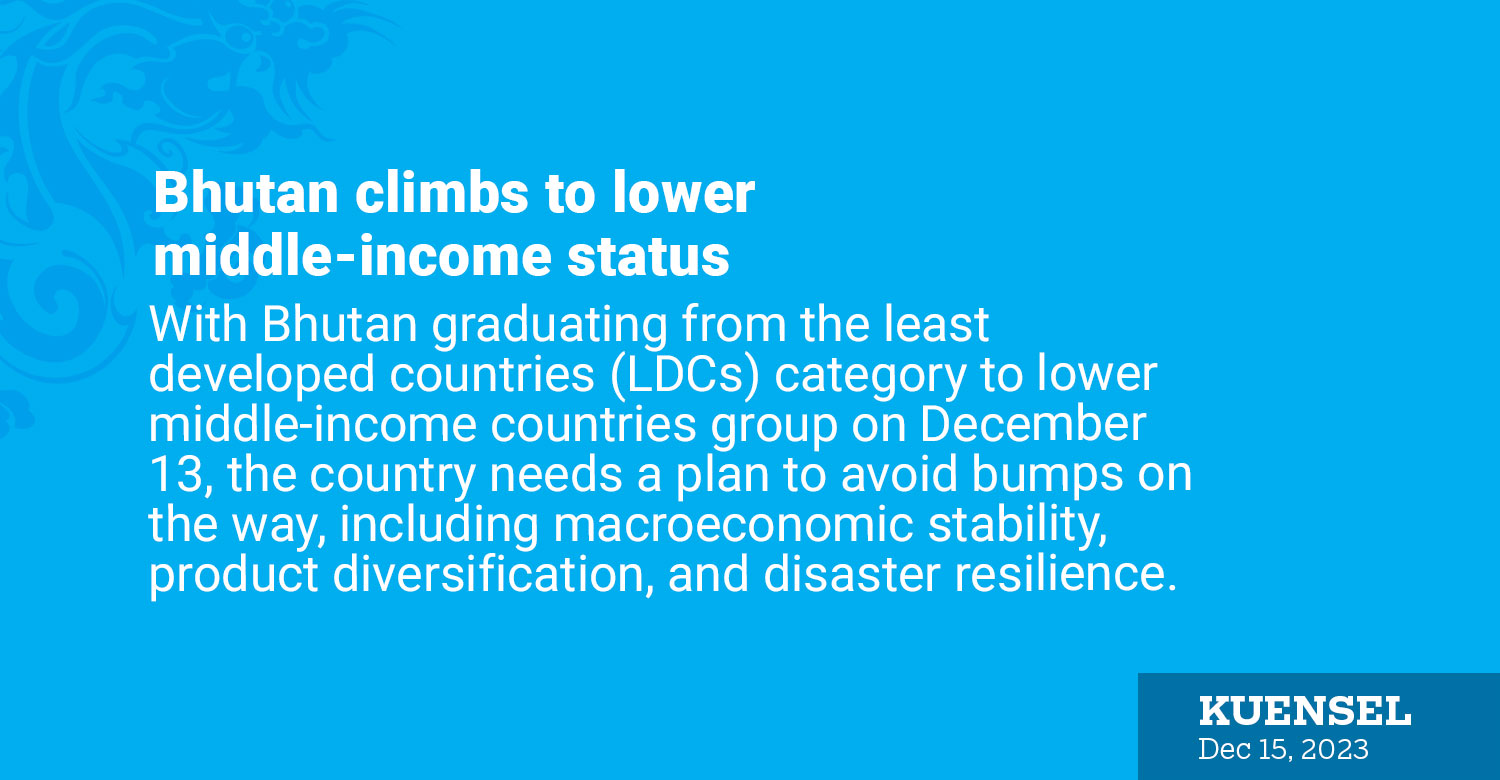…exits LDC status on December 13
Thukten Zangpo
With Bhutan graduating from the least developed countries (LDCs) category to lower middle-income countries group on December 13, the country needs a plan to avoid bumps on the way, including macroeconomic stability, product diversification, and disaster resilience.
For the smooth transition, the UN’s Committee for Development Policy (CDP) shared the challenges, that includes mobilisation of domestic resources and prudent management of hydropower revenues to substitute for declining foreign grants and maintain macroeconomic stability. Bhutan received USD 181 million as official development assistance in 2019.
Bhutan, in its 13th Plan with the budget outlay of Nu 512 billion will be helpful for the smooth transition from LDCs.
Bhutan has met all the graduation criteria set by the UN: gross national income (GNI) per capita, human assets index (HAI) of 66 or above, and economic and vulnerability index (EVI) of 32 or below.
According to the CDP report, in 2022, Bhutan’s GNI per capita was reported at USD 3, 044.6 above LDCs threshold of USD 1, 222 over a three-year average, HAI at 79.8 against 66 and above criteria for graduation and its EVI was 25.5 when the criteria required is 32 and below.
Countries that meet two of the three LDC criteria become eligible for graduation from the category. This may also qualify if the GNI of the country is at least twice the graduation threshold (USD 2,444) in two consecutive reviews.
With Bhutan graduating from LDC status, access to concessional financing from external sources will be limited.
At the same time, Bhutan could lose the edge of economic benefits such as duty-free and quota-free access to developed countries’ markets, allowing for increased exports and access to new markets, which can lead to economic development.
However, given Bhutan’s economy closely linked with India with more than 80 percent imports and exports from India, and pegged currency, which has helped to maintain the country’s macro stability.
An economist said that Bhutan would lose some donors, but India providing the majority of the donor funding, the impact would be minimal.
As the country aims for economic growth of USD 5 billion by 2029 and USD 10 billion by 2034, an economist added that a high level of investment would be required (both government and private), requiring high access to financial resources, and Indian government funding may not be adequate to meet those needs.
The UN’s CDP report stated that Bhutan will not get LDC related climate funds like Global Environment Facility (GEF) through least developed countries fund (LDCF), however, will receive general support through the GEF.
While Bhutan will remain eligible for the Green Climate Fund (GCF), its access might see a slight decrease.
Under GCF’s country readiness and preparatory support programme, 50 percent of its total resources are allocated to LDCs, small island developing states, and the African states.
However, the UNs office of the High Representative for the Least Developed Countries, Landlocked Developing Countries and Small Island Developing Countries (OHRLLS), UNs Conference on Trade and Development (UNCTAD), UNs Economic and Social Commission for Asia and the Pacific (UNESCAP), and World Food Programme had made commitment to provide technical support to Bhutan’s smooth transition.
After graduation up to five years, Bhutan is also expected to receive support measures such as the Enhanced Integrated Framework (EIF), United Nations Capital Development Fund (UNCDF), and the UN Technology Bank.
A country’s LDC status is not a factor for determining eligibility for Asian Development Bank and World Bank assistance.
The UNCTAD stated that the measurable progress justifying an LDC’s graduation doesn’t necessarily equal economic transformation or the sophistication of support needed to steer the economy through its next phase of development.
However, a failure to mitigate these challenges would have impacts such as losing several LDC-specific trade preferences – risk exacerbating Bhutan’s exposure to external shocks and undermining efforts to diversify its economy and exports.
To drive post-graduation growth, UNCTAD said that the need for further reforms to ensure synergies and coherence across Bhutan’s foreign direct investment, industrial and entrepreneurship policies.
As Bhutan currently faces moderate levels of debt distress, there is a need to strengthen its development finance and acquire technical assistance in devising risk mitigation measures.
In addition to securing a longer phase-out period of trade preferences, Bhutan will require continued support from international partners to strengthen its business infrastructure, notably the country’s four industrial parks.
Following its graduation from LDC status, Bhutan will undergo a three-year monitoring phase to ensure its continued development strategy and avoid slipping back into the LDC category.
With Bhutan’s LDCs graduating, the number of LDCs is down to 45. Bhutan is the seventh country to change status, or graduate since the UN General Assembly in 1971, following Botswana (1994), Cabo Verde (2007), the Maldives (2011), Samoa (2014), Equatorial Guinea (2017), and Vanuatu (2020). The UN’s CDP conducts a review of the LDCs every three years.
Bangladesh and Nepal have delayed their graduations until 2026.


